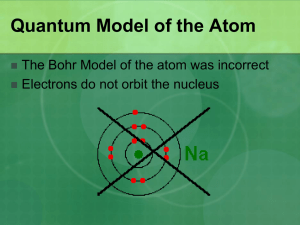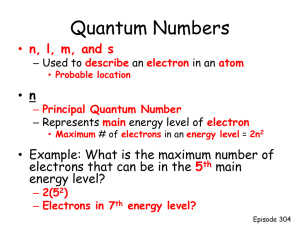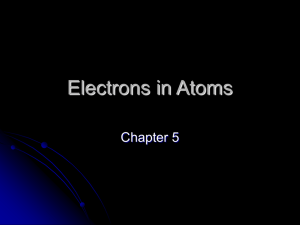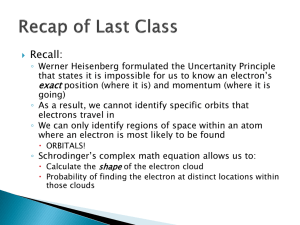Chapter 7 Atomic Structure and Periodicity
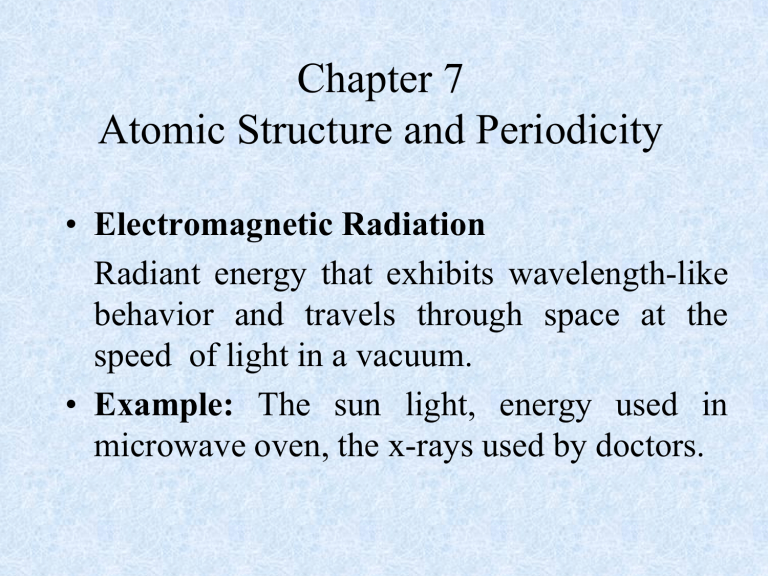
Chapter 7
Atomic Structure and Periodicity
•
Electromagnetic Radiation
Radiant energy that exhibits wavelength-like behavior and travels through space at the speed of light in a vacuum.
•
Example: The sun light, energy used in microwave oven, the x-rays used by doctors.
Waves
Waves have 3 primary characteristics:
1. Wavelength (
): distance between two consecutive peaks in a wave.
2. Frequency (
): number of waves (cycles) per second that pass a given point in space.
3. Speed: speed of light is 2.9979
10 8 m/s. We will use 3.00 x10 8 m/s.
The Nature of Waves
Wavelength and frequency can be interconverted and they have an inverse relationship
=
c
/
= frequency (s
1 )
= wavelength (m) c = speed of light (m s
1 )
• Wavelength is also given in nm (1 nm = 10 -9 m) and Angstroms (Å) (1 Å = 10 -10 m).
• The frequency value of s
1 or 1/s is also called
“hertz (Hz)” like KHz on the radio.
Classification of Electromagnetic Radiation
Example: When green light is emitted from an oxygen atom it has a wavelength of 558 nm.
What is the frequency?
We know,
= c/
.
.
.
.
8 m s
14 s
7 m
1
14
Hz where, c = speed of light
= 3.00 x 10 8 m/s
= wavelength
= 558 nm
(need to convert in m)
558 nm
9
10 m
1 nm
7
558 10 m
Planck’s Constant
• Transfer of energy is quantized, and can only occur in discrete units, called quanta.
E h
hc
E = change in energy, in J h
= Planck’s constant, 6.626
10
34 J s
= frequency, in s
1
= wavelength, in m
• Example: The Blue color in fireworks is often achieved by heating copper (I) chloride (CuCl) to about 1200 o C. Then the compound emits blue light having a wavelength of 450 nm. What is the increment of energy (the quantum) that is emitted at 4.50 x
10 2 nm by CuCl?
The quantum of energy can be calculate from the equation
E = h
The frequency
for this case can be calculated as follows:
c
2 9979 10
8 m s
7 m
14 s
1
So,
E = h
= (6.626 x 10 -34 J.s)(6.66 x 10 14 s -1 )
= 4.41 x 10 -19 J
A sample of CuCl emitting light at 450 nm can only lose energy in increments of 4.41 x 10 -19 J, the size of the quantum in this case.
Energy and Mass
• According to Einstein theory of relativity-
Energy has mass; Einstein equation,
E = mc 2 where, E = energy, m = mass c = speed of light
• After rearrangement of the equation, m
E
2 c
Now we can calculate the mass associated with a given quantity of energy
• Einstein suggested that electromagnetic radiation can be viewed as a stream of “particles” called photons . The energy of each photon is given by,
E photon
= h
= hc
m photon
=
E
2
= c hc /
c
2
= h
c
• It was Einstein who realized that light could not be explained completely as waves but had to have particle properties. This is called the dual nature of light .
Electromagnetic Radiation
Wavelength and Mass
• de Broglie thought if waves like light could have particle properties that particles like electrons could have wave properties. We have, m
h c
m de Broglie’s equation,
h
= velocity h m
= wavelength (m); m = mass (kg);
= velocity (m/s) h
= Planck’s constant, 6.626
10
34 J s = kg m 2 s
1
• This equation allows us to calculate the wavelength of a particle. Matter exhibits both particulate and wave properties.
•
Example: Compare the wavelength for an electron
(mass = 9.11 x 10 -31 kg) traveling at a speed of 1.0 x
10 7 m/s with that for a ball (mass = 0.10 kg) traveling at
35 m/s.
We use the equation
= h/m
, where h = 6.626
10
34 J.s or 6.626
10
34 kg m 2 /s since, 1 J = 1 kg. m 2 /s 2
For the electron,
e
For the ball,
.
b
34
.
31
.
s
kg 10 10
7 m s
.
34
.
kg 35 / s
.
11 m
34 m
Atomic Spectrum of Hydrogen
• When H
2 molecules absorb energy, some of the H-H bonds are broken and resulting hydrogen atoms are excited. The excess energy is released by emitting light of various wavelengths to produce the emission spectrum of hydrogen atom.
• Continuous spectrum: Contains all the wavelengths of light.
Line (discrete) spectrum: Contains only some of the wavelengths of light. Only certain energies are allowed, i.e., the energy of the electron in the hydrogen atom is quantized.
E h
hc
A Continuous Spectrum (a) and A Hydrogen Line Spectrum (b)
A Change between Two Discrete Energy Levels
The Bohr Model
• The electron in a hydrogen atom moves around the nucleus only in certain allowed circular orbits. The energy levels available to the hydrogen atom:
E
18 2
= 2.178 10 J ( / )
2
E = energy of the levels in the H-atom z = nuclear charge (for H, z = 1) n = an integer, the large the value, the larger is the orbital radius.
• Bohr was able to calculate hydrogen atom energy levels that exactly matched the experimental value. The negative sign in the above equation means that the energy of the electron bound to the nucleus is lower than it would be if the electron were at an infinite distance.
Electronic Transitions in the Bohr Model for the Hydrogen Atom
•
Ground State : The lowest possible energy state for an atom ( n = 1).
•
Energy Changes in the Hydrogen Atom
E = E final state
E initial state
= -2.178 x 10 -18 J
1 n 2 final
1 n 2 initial
• The wavelength of absorbed or emitted photon can be calculated from the equation,
E
h
c
= hc
E
Example: Calculate the energy required to excite the hydrogen electron from level n = 1 to level n =
2. Also calculate the wavelength of light that must be absorbed by a hydrogen atom in its ground state to reach this excited state.
Using Equation, E
18 2 z n
2
/ ) we have with Z = 1
E
1
E
2
= -2.178 x 10 -18 J(1 2 /1 2 ) = -2.178 x 10 -18 J
= -2.178 x 10 -18 J(1 2 /2 2 ) = -5.445 x 10 -19 J
E = E
2
- E
1
= (-5.445 x 10
= 1.633 x 10 -18 J
-19 J) – (-2.178 x 10 -18 J)
The positive value for
E indicates that the system has gained energy. The wavelength of light that must be absorbed to produce this change is
hc
E
(6.626 x 10 -34 J.s)(2.9979 x 10 8 m/s)
1.633 x 10 -18 J
= 1.216 x 10 -7 m
Example: Calculate the energy required to remove the electron from a hydrogen atom in its ground state.
Removing the electron from a hydrogen atom in its ground state corresponds to taking the electron from n initial
= 1 to n final
=
. Thus,
E = -2.178 x 10 -18 J
1
2 n final
1
= -2.178 x 10 -18 J n
2 initial
1
1
1
2
The energy required to remove the electron from a hydrogen atom in its ground state is 2.178 x 10 -18 J.
Quantum Mechanics
Based on the wave properties of the atom
Schrodinger’s equation is (too complicated to be detailed here),
= E
= wave function
= mathematical operator
E = total energy of the atom
A specific wave function is often called an orbital.
This equation is based on operators – not simple algebra. This is a mathematical concept you will not have dealt with yet.
Heisenberg Uncertainty Principle
x = position
h
4
mv = momentum h = Planck’s constant
The more accurately we know a particle’s position, the less accurately we can know its momentum. Both the position and momentum of a particle can not be determined precisely at a given time. The uncertainty principle implies that we cannot know the exact motion of the electron as it moves around the nucleus.
Radial Probability Distribution
Quantum Numbers (QN)
When we solve the Schrodinger equation, we find many wave functions (orbitals) that satisfy it. Each of these orbitals is characterized by a series of numbers called quantum numbers, which describe various properties of the orbital.
1. Principal QN ( n = 1, 2, 3, . . .) - related to size and energy of the orbital.
2. Angular Momentum QN ( l = 0 to n
1) - relates to shape of the orbital. l = 0 is called s; l = 1 is called p; l = 2 is called d; l = 3 is called f.
3. Magnetic QN ( m l
= l to
l including 0) - relates to orientation of the orbital in space relative to other orbitals.
4. Electron Spin QN ( m s spin states of the electrons.
= + 1 /2,
1 /2) - relates to the
Example: For principal quantum level n = 5, determine the number of allowed subshells
(different values of l ), and give the designation of each.
For n = 5, the allowed values of l run from 0 to 4
(n – 1 = 5 – 1). Thus the subshells and their designations are l = 0 l = 1 l = 2 l = 3 l = 4
5s 5p 5d 5f 5g
Orbital Shapes and Energies
Two types of representations for the hydrogen 1s,
2s and 3s orbitals are shown below. The s orbitals are spherical shape.
Two Representations of the
Hydrogen 1s, 2s, and 3s Orbitals
Representation of p orbitals
The p orbitals are not spherical like s orbital but have two loves separated by a node at the nucleus. The p orbitals are labeled according the axis of the xyz coordinate system.
The Boundary Surface Representations of All Three 2p Orbitals
Representation d orbitals
The five d orbital shapes are shown below. The d orbitals have two different fundamental shapes.
The Boundary Surfaces of All of the 3d Orbitals
Energy Diagram for Hydrogen Atom
The energy of a particular orbital is determined by its value of n. All orbitals with the same value of n have the same energy and are said to be degenerate . Hydrogen single electron occupy the lowest energy state, the ground state .
If energy is put into the system, the electron can be transferred to higher energy orbital called excited state .
Orbital Energy
Levels for the
Hydrogen Atom
Pauli Exclusion Principle
• In a given atom, no two electrons can have the same set of four quantum numbers ( n , l , m l
, m s
).
•
Therefore , an orbital can hold only two electrons, and they must have opposite spins.
Polyelectronic Atoms
• For polyelectronic atoms in a given principal quantum level all orbital are not in same energy
(degenerate). For a given principal quantum level the orbitals vary in energy as follows:
E ns
< E np
< E nd
< E nf
• In other words, when electrons are placed in a particular quantum level, they prefer the orbital in the order s, p, d and then f.
Aufbau Principle
As protons are added one by one to the nucleus to build up the elements, electrons are similarly added to these hydrogen-like orbitals.
H : 1s 1 , He : 1s 2 , Li : 1s 2 2s 1 , Be : 1s 2 2s 2
B : 1s 2 2s 2 2p 1 , C : 1s 2 2s 2 2p 2 .
Hund’s Rule
The lowest energy configuration for an atom is the one having the maximum number of unpaired electrons allowed by the Pauli principle in a particular set of degenerate orbitals.
N : 1s 2 2s 2 2p 3 , O : 1s 2 2s 2 2p 4 ,
F : 1s 2 2s 2 2p 5 , Ne : 1s 2 2s 2 2p 6 ,
Na : 1s 2 2s 2 2p 6 3s 1 OR [Ne] 3s 1
The Electron Configurations in the Type of
Orbital Occupied Last for the First 18 Elements
Valence Electrons
The electrons in the outermost principle quantum level of an atom.
Atom Valence Electrons
Ca
N
2
5
Br 7
Valence electron is the most important electrons to us because they are involved in bonding.
Elements with the same valence electron configuration show similar chemical behavior.
Inner electrons are called core electrons.
Electron Configurations for Potassium Through Krypton
The Orbitals Being Filled for Elements in Various Parts of the Periodic Table
The Periodic Table With Atomic Symbols, Atomic
Numbers, and Partial Electron Configurations
Broad Periodic Table Classifications
• Representative Elements (main group): filling s and p orbitals (Na, Al, Ne, O)
• Transition Elements: filling d orbitals (Fe, Co, Ni)
• Lanthanide and Actinide Series (inner transition elements): filling 4 f and 5 f orbitals (Eu, Am, Es)
The Order in which the Orbitals Fill in Polyelectronic Atoms
Ionization Energy
The quantity of energy required to remove an electron from the gaseous atom or ion.
X
(g)
X +
(g)
+ e where, the atom or ion is assumed to be in its ground state.
Periodic Trends
First ionization energy: increases from left to right across a period; decreases going down a group.
The Values of First Ionization Energy for
The Elements in the First Six Periods
Trends in Ionization Energies for the Representative Elements
Electron Affinity
The energy change associated with the addition of an electron to a gaseous atom.
X( g ) + e
X
( g )
These values tend to be exothermic (energy released). Adding an electron to an atom causes it to give off energy. So the value for electron affinity will carry a negative sign.
The Electronic Affinity Values for Atoms Among the
First 20 Elements that Form Stable, Isolated X Ions
Periodic Trends
Atomic Radii: Atomic radii can be obtained by measuring the distances between atoms in chemical compounds and atomic radius is assumed to be half this distance.
• Decrease going from left to right across a period.
This decrease can be explained in terms of the increasing effective nuclear charge in going from left to right. The valence electron are drawn closer to the nucleus, decreasing the size of the atom.
• Increase going down a group, because of the increase in orbital sizes in successive principal quantum levels.
The Radius of an Atom
Atomic Radii for Selected Atoms
Information Contained in the Periodic Table
1. Each group member has the same valence electron configuration. Group elements exhibit similar chemical properties.
2. The electron configuration of any representative element can be obtained from periodic table. Transition metals – two exceptions, chromium and copper.
3. Certain groups have special names (alkali metals, halogens, etc).
4. Metals and nonmetals are characterized by their chemical and physical properties. Many elements along the division line exhibit both metallic and non metallic properties which are called metalloids or semimetals.
Special Names for Groups in the Periodic Table
Summary
• Electromagnetic Radiation: Wavelength like behavior.
• Frequency,
= c /
(
= wavelength, c = speed of light).
• Energy Transfer,
E = h
= hc/
• de Broglie’s Equation:
= h/m
• The Bohr Model: electron in a hydrogen atom moves around the nucleus only in certain allowed circular orbits.
• Quantum Mechanics: H
= E
• Heisenberg Uncertainty Principle: Position and momentum cannot be determined precisely at a given time.
• Quantum Numbers: Principal QN, Angular momentum QN, Magnetic QN, an Electron Spin
QN.
• Orbital Shapes and Energies: s, p, and d orbitals.
• Pauli Exclusion Principle:
• Aufbau Principle:
• Hund’s Rule:
• Periodic Table:
• Ionization Energy:
• Electron Affinity:
• Periodic Trends:

